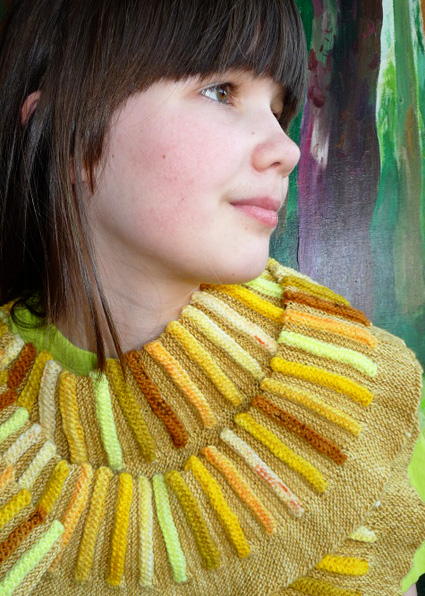

|
|
|

Shaping in knitting is usually achieved by using short rows or increasing and/or decreasing the number of stitches. However, in this shawlish scarf (or scarfish shawl), shaping is achieved in a different way, namely by gathering together the stitches of part of the project, in order to create what look like steps. When these steps are created at regular intervals, a circular shape appears. Apart from being a construction element, the steps also stand out as a visual element, especially when they are knitted in a contrasting color. Note that this pattern uses up more yarn than if you were to knit a regular garter stitch scarf or cowl -- the steps use up lots more yarn that a flat fabric would. In addition, the more color changes in the ridges, the more ends there are to weave in. But, having said that, I think that the advantage of making this very cool looking scarf outweighs the disadvantages by far! |
||
|
|

|
Tweet
 |
|
SIZE |
|
|
FINISHED MEASUREMENTS |
|
MATERIALS Notions |
|
GAUGE |
| 27 sts/54 rows (27 ridges) = 4 inches in garter stitch |
|
PATTERN NOTES |
I used fingering weight yarn for my project, but you can knit this pattern with any type or thickness of yarn, the gauge doesn't matter. Just decide how wide you want your scarf/shawlette to be, and then using the gauge information, calculate how many stitches you have to cast on to achieve this width. Then divide that roughly in thirds, working the step on the last two-thirds of the row. Length, of course, is easily adjustable. The Intarsia method is used to work the color sections. Join CC at the point you need to start working it. Twist yarns around each other when changing colors. |
|
This photo shows you what row 1 of section B looks like on the RS, just before you start the process of knitting stitches together to start creating a step.
This photo shows you what row 1 of section B looks like on the WS, just before you start the process of knitting stitches together to start creating a step. With the tip of the left needle, pick up the MC loop of the first stitch of the first CC row. ...and knit this loop together with the first stitch on the left needle. Continue this process across the rest of the row.
This is what your work looks like at the end of the row, when your new step is finished. |
|
DIRECTIONS Section A Section B Repeat Sections A & B until shawl measures 100 inches, or a little short of desired final length. Work Section A once more. |
|
FINISHING |
| ABOUT THE DESIGNER |
|
Ellen Easton lives in the Netherlands. She has been knitting and crocheting almost as long as she can remember, and she loves to design her own patterns. |
|
Pattern & images © 2013 Ellen Easton. Contact Ellen |